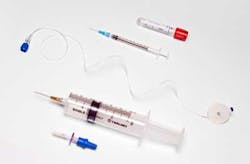A cutting-edge solution for dental sharps
Aug. 27, 2009
By Dr. Burton J. Kunik
In a story that was widely reported on the Internet, a section of the New Jersey coast in August 2008 experienced medical waste washing up on shore areas used by thousands of vacationers. Ultimately, responsibility for the incident was placed with a Pennsylvania dentist who allegedly took his boat offshore and dumped from it the used needles and similar hazardous waste materials from his dental office. The incident was a graphic illustration of how 20 years after the passage of the Medical Waste Tracking Act, which was meant to protect the public and our environment from the dangers of medical waste, improper disposal by a single dentist can have a huge impact. Regulated wasteOne can only assume why this dentist dumped his medical waste into the ocean. If it was simply to save money, perhaps if he was properly segregating his medical waste from ordinary office trash, and thus reducing his medical waste disposal costs, the idea of improper disposal would not have been so tempting. And equally plausible is the idea that if the dentist actually understood what constituted medical waste, proper disposal would not have seemed like a major challenge.There is a definition of what constitutes the problem. Treatment by-products such as used gloves, masks, gowns, patient bibs, lightly soiled gauze or cotton rolls, and plastic barriers are not typically considered regulated medical waste. According to the Centers for Disease Control and Prevention, only 1% to 2% of dental office waste is actually regulated medical waste, with needles and other medical sharps composing the bulk of that material. Regulated medical waste from a dental office includes:
- Gauze saturated with blood after surgery
- Extracted teeth (without amalgam); and hard and soft tissue
- Contaminated sharps – needles, carpules, broken sharp instruments, dental wires, endo files, scalpel blades, and suture needles.
Former dentist Dr. Burton J. Kunik is chairman and chief executive officer of Sharps Compliance Corp., a leading provider of cost-effective disposal solutions for medical and pharmaceutical waste generated outside the hospital setting, www.sharpsinc.com. Dr. Kunik can be reached at (713) 432-0300 or [email protected].








